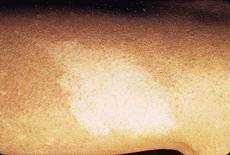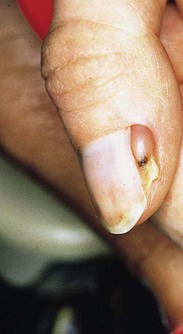200 Tuberous sclerosis (Bourneville’s or Pringle’s disease)
Salient features
Examination
• Angiofibromas (adenoma sebaceum) distributed in a butterfly pattern over the cheeks (Fig. 200.1), chin and forehead
• Shagreen patches: leathery thickenings in localized patches over the lumbosacral region
• Ash-leaf patches: hypopigmented areas (Fig. 200.2)
• Subungual fibromas (Fig. 200.3)

Fig. 200.1 Tuberous sclerosis: angiofibromas in a butterfly pattern over the cheeks, chin and forehead.
Advanced-level questions
Give some examples of the appearance of clinical manifestations at distinct developmental points
• Hypopigmented macules (formerly known as ash-leaf spots) are usually detected in infancy or early childhood.
• Shagreen patch is identified with increasing frequency after the age of 5 years.
• Ungual fibromas characteristically appear after puberty and may develop in adulthood.
• Facial angiofibromas (formerly called adenoma sebaceum) may be detected at any age but are generally more common in late childhood or adolescence.
• Cortical tubers and cardiac rhabdomyomas form are typical findings in infancy because they form during embryogenesis.
• A subependymal giant cell tumour of the brain may develop in childhood or adolescence.
• Renal cysts can be detected in infancy or early childhood.
• Angiomyolipomas develop in childhood, adolescence or adulthood.
• Pulmonary lymphangiomyomatosis is found in adolescent girls or women
Stay updated, free articles. Join our Telegram channel

Full access? Get Clinical Tree




